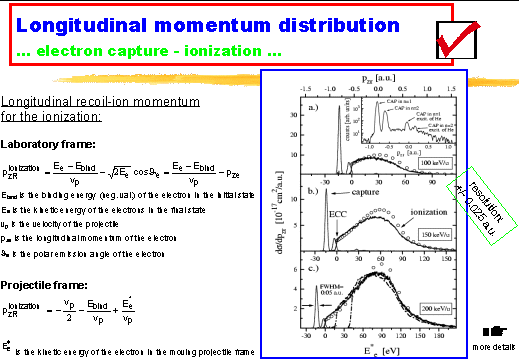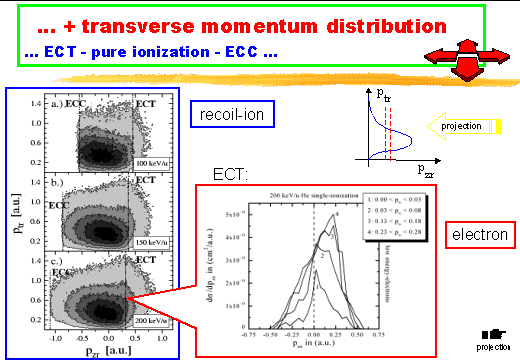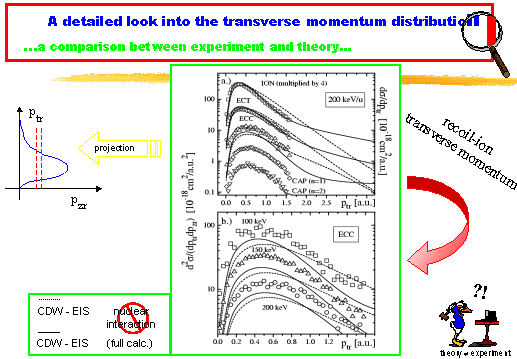Abrupt rise of the longitudinal recoil ion momentum distribution for ionizing collisions
|
ABSTRACT We report on the experimental observation of an abrupt rise in the longitudinal momentum distribution of recoil-ions created in proton helium collision. The details of this structure can be related to electrons travelling with the velocity of the projectile (electron capture to the continuum ECC). The longitudinal as well as the transverse distribution of the recoil-ions can be explained as a continuation of the momentum distribution from ions resulting from electron capture illustrating the smooth transition from the capture to bound states of the projectile to the ECC. INTRODUCTION
The momentum distribution of the fragments in the final state of an atomic collision is the main source of information on the dynamics of such ionization processes. Of particular interest are discrete structures in these momentum distributions, which are directly linked to a particular mechanism or to a special kinematical scenario of how the ionization proceeds. In the momentum distribution of ionized continuum electrons three of such distinct structures are known: 1. A spherical ridge in the velocity space, centered on the projectile velocity, resulting from the Binary Encounter (BE) between the projectile and a quasi-free target electron. And 2. + 3. two peaks at the target- and at the projectile velocity, resulting from very slow electrons ("target-cusp" or Electron Capture to the Target ECT, see [1], [2]) and electrons travelling with the projectile without being bound (Electron Capture to the Continuum ECC; see [3], [4], [5] and references therein and [6] for a review).
EXPERIMENTAL METHOD Details on the experimental technique of Cold Target Recoil Ion Momentum Spectroscopy (COLTRIMS) used for this experiment can be found elsewhere (see [7] for more detailed information on the experimental setup used for this experiment and [9] for a review). In brief a precooled supersonic gas jet is crossed with a pulsed ion beam. Up- and downstream of the target gas jet the ion beam is charge state analyzed by electrostatic deflectors. If a projectile is neutralized it is detected by a channel plate detector. An electrostatic field guides the recoil-ions created in the overlap region onto another position-sensitive channel plate detector. From the position of impact on the detector and the time-of-flight the three components of the recoil-ion momentum vector can be determined. With this configuration we were able to measure the recoil-ion momentum distributions for all recoil-ions and simultaneously the ions from single capture reaction only. Since capture leads to clearly separable lines in the recoil-ion momentum distributions, the two measured distributions can be normalized very exactly with respect to each other and the momentum distributions for the pure ionization channel can be obtained just by subtracting these two distributions. RESULTS AND DISCUSSION In Figure 1 the recoil-ion longitudinal momentum distribution for the ionizing (solid line) and the capture-processes (dotted line) for projectile energies of 100, 150 and 200 keV/u are shown. The existence of a minimum value (indicated by ECC in figure 1b) is just a consequence of momentum and energy conservation, i.e. purely a consequence of kinematics. It bears no information on the dynamics or any other detail of the reaction. The physical information lies in the fact in which way the kinematically allowed phase-space is populated. It is remarkable that the cross section has a finite value, i.e. an abrupt rather than a smooth rise. Rodríguez and coworkers have predicted this abrupt rise within a Continuum Distorted Wave Eikonal Initial State (CDW-EIS) calculation (see [8]). They argued that this is a mirror image of the ECC peak in the electron momentum distribution. 
One can also interpret the momentum distribution of figure 1 as a cross section single differential in the electron Energy (Ee) seen from the moving projectile. Ee is indicated by the additional bottom scales in figure 1. In the electron spectra of the laboratory frame the ECC leads to a divergence in the doubly differential cross section. In the projectile frame this divergence is not present, and the distribution shows a smooth transition across the continuum threshold (see figure 1). Thus the capture to highly excited states joins the ionization-continuum continuously across the ECC-edge.  
In conclusion we have found an abrupt rise of the recoil-ion longitudinal momentum distribution linked to the ECC electrons. At very small scattering angles (< 10-4 rad) capture to projectile states of n>1 and ionizing collision leading to the ECC show the same cross section per ion momentum phase space and the same transverse momentum exchange highlighting a smooth transition from capture to ionization in ion atom collisions. [1] W. Schmitt et al., Phys. Rev. Lett. 81, (1998), p.4337 [2] P.D. Fainstein, Phys. Rev. A 60, (1999), R 741-744 [3] G. B. Crooks et al., Phys. Rev. Lett. 25, (1970), p. 1599 [4] W. Meckbach et al., Phys. Rev. A 24, (1981), p. 1793 [5] J. Macek et al., Phys. Rev. Lett. 46, (1981), p. 1571 [6] N. Stolterfoht et al., Electron Emission in Heavy Ion-Atom Collisions, Springer-Verlag, (1997) [7] Th. Weber et al., J. Phys. B: At. Mol. Opt. Phys. 33, (2000), p. 3331 [8] V. Rodriguez et al., Phys. Rev. A 52, (1995), R 9 [9] R. Dörner et al., Phys. Rep. 330, Numbers 2-3, (June 2000), pp: 95-192 |